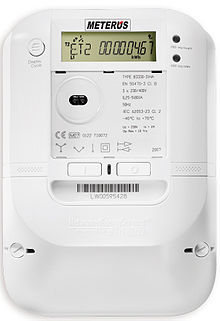|
Extending the eMeter Framework with CoAP (B)Status: Abgeschlossen
Abstract—The eMeter is a framework that enables convenient access to the data of a smart meter. This data can be used to get the energy consumption per appliance and in turn optimize the energy usage in households. The current eMeter prototype integrates a powerful embedded system into the smart meter and provides a local database with a RESTful interface exported through Wi-Fi. This thesis pursues a non-intrusive approach by designing an inexpensive adapter that can be attached to the optical user interface most meters provide. It will leverage the Constrained Application Protocol (CoAP) to allow energy-efficient, Web-like access over 6LoWPAN. BackgroundGovernments and electric utility companies are pushing smart meters for households to reduce the overall energy consumption and to better match consumption with generation. With the existing eMeter framework, smart meters that provide an Ethernet interface can be upgraded to provide convenient data access through a RESTful interface over Wi-Fi. The framework consists of two parts: The first is a gateway based on the Gumstix platform, which polls the data, stores it in a database, and provides the RESTful interface. The second part is a client application for the user, which runs on a mobile phone or optionally in a Web browser. The client is used for data visualization and the metering of individual devices. The current gateway has to be plugged into a restricted smart meter interface, which is usually leaded by the utility companies. As a framework extension, we will design an adapter that reads the data from the unrestricted optical interface provided for users and meter readers. The adapter will be based on a battery-powered wireless module harboring a microcontroller. We will leverage the Constraint Application Protocol (CoAP), a light-weight, Web-like protocol that builds upon energy-efficient communication over 6LoWPAN. The adapter will only features a parser for the data from the smart meter's IR interface and a RESTful interface for remote access via CoAP. Data storage and processing will happen on a more powerful machine that directly supports CoAP or makes use of the HTTP-CoAP mapping through a transparent proxy. As a starting point, we will use the Volkszähler project, which also aims at open access to smart meters and already provides a kit for an IR/RS-232 adapter. ObjectivesIn a first step, the student shall assemble a read/write head for the optical interface of the smart meter based on the Volkszähler kit. The RS-232 part is omitted, as the serial TTL signal will be directly fed into a deRFmega128 wireless module later. Second, the student shall analyze and document the functionalities implemented by the smart meter provided. With this knowledge, an SML parser should be implemented in C and tested by connecting the read/write head stub to a computer. In a third step, the student shall design and implement the RESTful interface for the wireless module. For this, the student shall use Contiki's Erbium REST Engine. After successful unit testing, all components shall be integrated into a compact smart meter adapter. It shall be evaluated and compare to the existing eMeter solution based on the Gumstix platform. Student/Bearbeitet von: Stefan WilliContact/Ansprechpartner: Matthias Kovatsch |
|
|